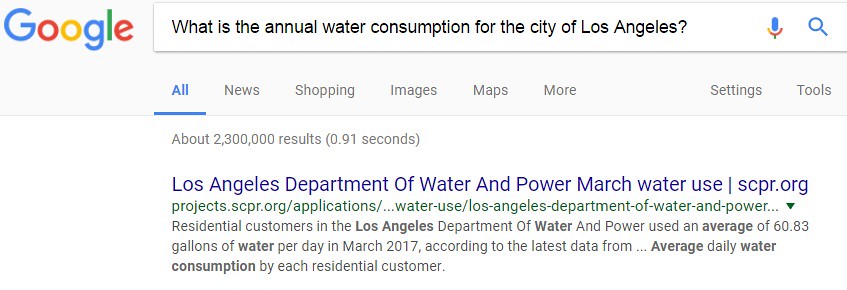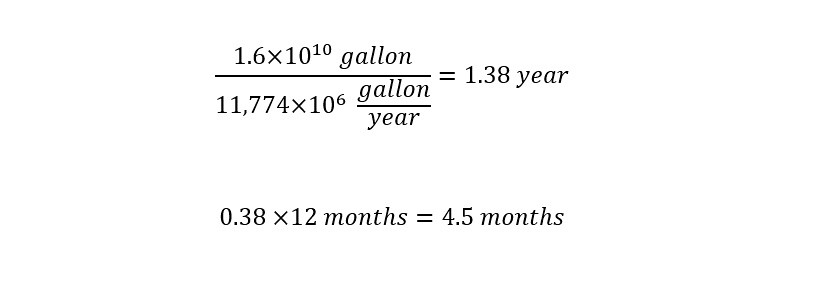After decades of court battles, mixed environmental reviews and bleak investor reports, the Cadiz project has recently taken a few steps forward. In a decision issued last May, an appellate court certified that Cadiz Inc. has the legal right to 50,000 acre-feet of the Mojave groundwater per year for the next 50 years. Then, early last month, the White House removed a restriction on a federal railroad right of way, effectively allowing Cadiz to build a new pipeline for moving the water to the existing aqueduct without undergoing a federal environmental review. And now a Cadiz lobbyist and shareholder, David Bernhardt, is under consideration for the No. 2 position at the Department of Interior, where, if confirmed by the Senate, he would help decide the future of the project.
There were two immediate thoughts running through my head after reading the above excerpt:
1) How much water is 50,000 acre-feet?
2) How does that compare to the need of a large city like Los Angeles?
Below, I carry out a couple of calculations which answer the above two questions. Enjoy!
50,000 Acre-Feet Of Water?
As I just mentioned, when I first read the excerpt above I was amazed that any water could be drawn from a dry lake bed. This just goes to prove that "dry dirt" is not dirt without water. If the water regulators of the Southern California region plan to withdraw a total of 50,000 acre-feet worth of water on an annual basis, then understanding the quantity reported would be nice.
In order to start, I decided to type into the search engine 'Google.com' the following: How many gallons are in an acre-foot? The following image appeared before a few links to sources shown below:
With the conversion factor from units of 'acre-feet' to units of 'gallons' now in hand, the straightforward unit conversion can be carried out as shown below:
Alright? WOW! Before I evaluate the answer above, I should clarify the number on the left hand side of the equation above. The value 50,000 acre-feet is expressed in scientific notation shown below:
Now that the representation of the value has been clarified, there is one other clarification. The unit "acre-foot" is confusing at first sight. Therefore, a search using 'Google.com' by entering the question: What are the dimensions of an acre? -- will yield the answer shown below:
Which fits into the unit - "acre-foot" visually as follows:
In the diagram above, the unit of an 'acre-foot' is represented visually. Shown above is a rectangle. The surface area of the top of the rectangle are the dimensions of an acre. To make a volume, the third dimension is the height which is equal to 1 foot. In the diagram above, the unit 'acre-foot' is the total amount of water that is contained in the volume of an acre which is 1 foot deep.
The answer from the unit conversion of 'acre-feet' to 'gallons' yielded the answer of 16 billion gallons of water. From the excerpt above taken from the article, this volume represents the annual amount of water which is extracted from the Cadiz Valley dry lake bed to direct toward Southern California cities for consumption.
How does a person visualize the volume of 16 billion gallons of water?
In order to understand the volume of 16 billion gallons which is extracted annually from the Cadiz Valley dry lake bed, a metric is needed. Since the amount is reported in terms of water usage. To start the comparison, the annual water consumption of Los Angeles needs to be known. Again, type into a search engine the following question: What is the annual water consumption for the city of Los Angeles? The answer to the search is shown below:
If you click on the first entry, the following image appears shown below:
If the last year -- 2017 annual water consumption is used to cast the large volume of water reported above, the following calculation is carried out by dividing the two numbers as shown below:
The answer states that using the annual consumption value of 11,774 million gallons per year -- the city of Los Angeles would be sustained for 1.38 years. Now, I imagine that you might have difficulty interpreting 1.38 years. Therefore, if the value of 0.38 is subtracted and multiplied by 12 months -- i.e. one year, the answer is 4 months.
Result: The annual water extraction from the Cadiz Valley dry lake bed is enough to supply the city of Los Angeles (population of 3.9 million residents) for a total of 16 months!!!
Conclusion...
As the results indicate the amount of water that is annually extracted from Cadiz Valley is a tremendous amount of water. Enough to supply the city of Los Angeles for 16 months -- which is impressive given that the Cadiz Valley is a dry lake. 16 billion gallons is easily determined through dimensional analysis of unit conversion given the tools available on the world wide web. These calculations are accessible to each of us. Give a calculation a try!!!
Until next time, have a great day!!








No comments:
Post a Comment